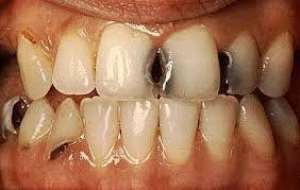
Naturally the enamel (outer covering) of our teeth contains about 96% of inorganic substances basically made up of calcium, phosphate and hydroxyl collectively known as HYDROXYAPATITE CRYSTALS (Ca10(PO4)6(OH)2) which is the strongest in the body whilst the organic component, basically collagen, and water make up the remaining 4%.
The teeth are robust and stronger than the bone because the bone contains only 70% of this hardest substance, the hydroxyapatite crystals and the teeth consist of 90% as elaborated above.
Normally after eating carbohydrates (fermentable) bacteria such as lactobacillus acidophillus and streptococcus mutants act on the fermentable carbohydrate and convert it into weak acidic basically lactic acid and citric acid, these acids reduce the PH of the mouth below the critical PH of the oral cavity (PH of 5.5), this causes subsurface demineralization and eventually dental cavities (tooth decay/dental caries) in the hardest substance in the body (teeth) if the is further decline in the PH of the mouth. Looking at this phenomenon there is the need to further fortify the teeth against this inevitable actions of the acid, though the body naturally tries to neutralize the effect of the acid through the saliva which contains buffer, fluoride and calcium ions for demineralization, antibacterial agents etc.
The good work of Dr Frederick MCcay and Dr. G. V. Black (father of restorative dentistry) provided the breakthrough for the practice of preventive dentistry with the use of fluoride through a forty-year research work. This was necessitated when the Dr. Frederick MCcay was faced with a strange teeth stains when he was posted to Colorado in 1901, which the the people termed as "Colorado stain" but Dr. MCcay termed it as "Mottled Enamel", these stains have now come to be known as "dental fluorosis" (caused by excessive intake of fluoride).
The work of these two eminent dentist led to the discovery of fluoride use in dentistry, fluoride use in dentistry was piloted at Grand Rapids in the USA in 1945 as community water fluoridation which saw the reduction of tooth decay or dental caries by at least 50% in the area of study whence the adoption of community water fluoridation as a preventive measure in tooth decay, no wonder all appropriate toothpaste currently in the market contain 525 to 1450 part per million (PPM) of fluoride. The fluoride works in several ways to ensure our teeth are well fortified to withstand the action of the weak bacterial acid without any cavity formation, these are few of their mechanism of action:
1. Strengthens teeth by the formation of harder enamel by converting HYDROXYAPATITE CRYSTALS to FLUORAPATITE CRYSTALS (Ca10(PO4)6F2) (more stronger and larger than hydroxyapatite). The fluoride ions replaces the Hydroxyl ions.
2. Inhibits bacterial enzyme system which convert sugars into acids in plaques.(F must be in ionic form)
3. Re-mineralizing existing dental cavities. (Phenomenon of arrested caries)
4. Modification in size and shape of teeth. When fluoride is given at the period of formation of teeth.
5. At high concentration Fluoride is toxic. Certain bacterial may be removed temporary during topical fluoride application. Etc.
Taking cognisance of the above elaborations it is very clear that fluoride plays a cardinal role in strengthening our teeth further and thereby reducing the incidence of tooth decay, making our smiling and general health better for greater socioeconomic and psychosocial growth. Make sure any toothpaste you buy contains fluoride. We have other formulations of fluoride like milks, tablets, mouth rinses, drops, salt etc, but that would be another discussion.
Shaibu Issifu
(President- Oral Health Students Association of Ghana (OHSAG))
0548437494




 Lay KPMG audit report on SML-GRA contract before Parliament – Isaac Adongo tells...
Lay KPMG audit report on SML-GRA contract before Parliament – Isaac Adongo tells...
 Supervisor remanded for stabbing businessman with broken bottle and screwdriver
Supervisor remanded for stabbing businessman with broken bottle and screwdriver
 NDC watching EC and NPP closely on Returning Officer recruitment — Omane Boamah
NDC watching EC and NPP closely on Returning Officer recruitment — Omane Boamah
 Your decision to contest for president again is pathetic – Annoh-Dompreh blasts ...
Your decision to contest for president again is pathetic – Annoh-Dompreh blasts ...
 Election 2024: Security agencies ready to keep peace and secure the country — IG...
Election 2024: Security agencies ready to keep peace and secure the country — IG...
 People no longer place value in public basic schools; new uniforms, painting wil...
People no longer place value in public basic schools; new uniforms, painting wil...
 'Comedian' Paul Adom Otchere needs help – Sulemana Braimah
'Comedian' Paul Adom Otchere needs help – Sulemana Braimah
 Ejisu by-election: Only 33% of voters can be swayed by inducement — Global InfoA...
Ejisu by-election: Only 33% of voters can be swayed by inducement — Global InfoA...
 Minority will expose the beneficial owners of SML, recover funds paid to company...
Minority will expose the beneficial owners of SML, recover funds paid to company...
 Prof. Opoku-Agyemang has ‘decapitated’ the NPP’s strategies; don’t take them ser...
Prof. Opoku-Agyemang has ‘decapitated’ the NPP’s strategies; don’t take them ser...
